
Odonata is an order of flying insects that includes the dragonflies and damselflies.

Barsboldia is a genus of large hadrosaurid dinosaur from the early Maastrichtian Nemegt Formation of Ömnogöv', Mongolia. It is known from a partial vertebral column, partial pelvis, and some ribs.

Catopsilia pomona, the common emigrant or lemon emigrant, is a medium-sized pierid butterfly found in Asia, Cambodia and parts of Australia. The species gets its name from its habit of migration. Some early authors considered them as two distinct species Catopsilia crocale and Catopsilia pomona.

The Gomphidae are a family of dragonflies commonly referred to as clubtails or club-tailed dragonflies. The family contains about 90 genera and 900 species found across North and South America, Europe, Asia, Australia, and Africa. The name refers to the club-like widening of the end of the abdomen. However, this club is usually less pronounced in females and is entirely absent in some species.

The Agromyzidae are a family of flies, commonly referred to as the leaf-miner flies for the feeding habits of their larvae, most of which are leaf miners on various plants. It includes roughly 2,500 species, they are small, some with wing length of 1 mm. The maximum size is 6.5 mm. Most species are in the range of 2 to 3 mm.

Tingena armigerella is a species of moth in the family Oecophoridae. T. armigerella is endemic to New Zealand where it is found in the North Island. The larvae of this species feed on plant litter. It is parasitised by the parasitic wasp Fustiserphus intrudens.

Ichneutica semivittata is a moth of the family Noctuidae. It is endemic to New Zealand. It can be found from the Three King Islands down to Stewart Island. The similar species I. sulcana can be distinguished from I. semivittata as the former is much larger, has a darker hindwing and abdomen and has only one to three spots located behind the middle of the forewing in comparison to the 8 or 9 of I. semivittata. This species lives in a variety of habitats from open grasslands to clearings in forest and at a range of altitudes from the sea level to the alpine zone. Larval host species include Juncus procera, Carex secta as well as on tussock grasses such as Poa cita, P. colensoi and Festuca novae-zelandiae. Adults of this species are on the wing from August to April and are attracted to light.

Synthemiopsis gomphomacromioides, also known as the Tasmanian spotwing, is a species of dragonfly from southern and north-western Tasmania, Australia. It is the only species in the genus Synthemiopsis and has also been placed in its own tribe, Synthemiopsini. R. J. Tillyard, who first described it, considered it intermediate between the Australian genus Synthemis and the Chilean Gomphomacromia. He had material from swamps around Cradle Mountain, at about 4,000 feet (1,200 m) altitude, and from Flowerdale Creek near Wynyard. Synthemiopsis gomphomacromioides flies rapidly over the swamps and often sits on reeds. It occurs together with Synthemis tasmanica, a similar but duller-coloured species.

Palaeovespa is an extinct genus of wasp in the Vespidae subfamily Vespinae. The genus currently contains eight species, five from the Priabonian stage Florissant Formation in Colorado, United States two from the middle Eocene Baltic amber deposits of Europe. and one species from the late Paleocene of France.

Ichneutica plena is a moth of the family Noctuidae. It is endemic to New Zealand. It is widespread throughout the North, South and Stewart Islands. It is a variable in appearance and therefore can be confused with its near relatives I. peridotea and I. insignis. The larvae of I. plena feed on herbaceous plants including Fuchsia excorticata, Coprosma species, and introduced species such as garden fuchsia as well as crops such as apple trees. Adults of this species are on the wing from late August until May.
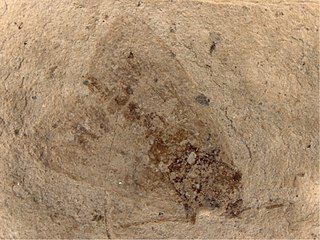
Paleolepidopterites is a collective genus of fossil moths which can not be placed in any defined family. The included species were formerly placed in the leaf-roller family Tortricidae and are known from fossils found in Russia and the United States. The collective genus contains three species: Paleolepidopterites destructus, Paleolepidopterites florissantanus, and Paleolepidopterites sadilenkoi, formerly placed within the genera Tortrix and Tortricites respectively. The three species were formally redescribed and moved to the new collective genus by Heikkilä et al. (2018).

Ichneutica atristriga is a moth of the family Noctuidae. It is endemic to New Zealand and is found through out the North, South and Stewart Islands. The larval hosts likely include tussock grasses included Poa cita, P. colensoi and Festuca novae-zelandiae. Larvae have been reared on species in the genera Bromus and Festuca. The adults of this species are on the wing from November to May. I. atristriga can possibly be confused with the smaller species I. propria. However I. atristriga has thorax and forewings that have a pinkish tinge and I. propria has a dark streak on the discal part of the forewing which I. atristriga lacks. A study has indicated that the population numbers of this species have decreased.

Lophocampa modesta is a moth of the family Erebidae. It was described by William Forsell Kirby in 1892. It is found in Costa Rica, Panama, Suriname, Ecuador, Bolivia, Peru and Venezuela.
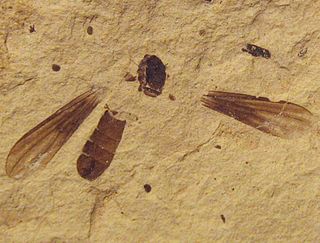
Metanephrocerus is an extinct genus of big-headed flies in the dipteran subfamily Protonephrocerinae, for which it is one of only two genera. The genus contains four described species, Metanephrocerus belgardeae, M. collini, M. groehni, and M. hoffeinsorum. Metanephrocerus is known from a group of Middle Eocene fossils which were found in Europe and a single early Eocene fossil from North America.

Holcorpa is a genus of extinct insects in the scorpionfly order Mecoptera. Two Eocene age species found in Western North America were placed into the genus, H. dillhoffi and H. maculosa.
Araripenymphes is an extinct genus of lacewing in the family Nymphidae known from fossils found in the Crato Formation of the Araripe Basin in South America. The genus contains a single species, Araripenymphes seldeni. The genus was named after the basin.
The Barbados myotis is a species of bat found in the Lesser Antilles. It was previously considered a subspecies of Schwartz's myotis, Myotis martiniquensis, but was elevated to species rank in 2012.
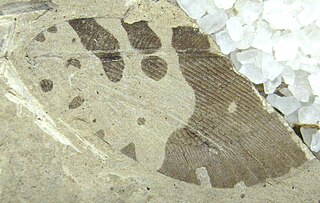
Palaeopsychops is an extinct genus of lacewing in the moth lacewings family Ithonidae. The genus is known from Early Eocene fossils found in Europe, and North America and is composed of ten species. The ten species can be informally separated into two species groups based on veination of the forewings, the "European" and "North American" groups. When first described, the genus was placed in the family Psychopsidae, but later was moved to Polystoechotidae, which itself is now considered a subgroup of the moth lacewings.
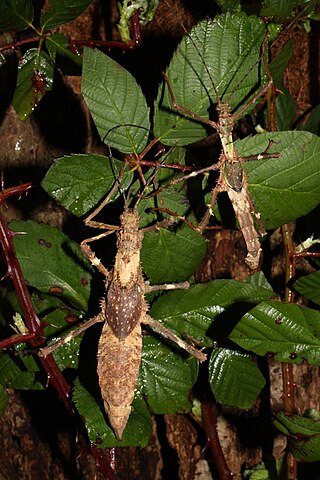
Haaniella is a genus of the Phasmatodea family Heteropterygidae from Southeast Asia.
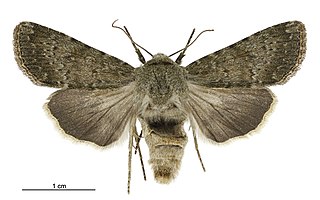
Ichneutica moderata is a moth of the family Noctuidae. This species is endemic to New Zealand and can be found from the Bay of Plenty south including the Chatham Islands. I. moderata inhabits open spaces in lowland to montane zones. Larvae likely feed on a variety of low growing herbaceous plants including on Raoulia species. Larvae create silk covered tunnels in the roots of their host plants. Pupa are enclosed in a loose silken cocoons and are sheltered amongst the host species roots. The adult moths are on the wing from October to April.


















